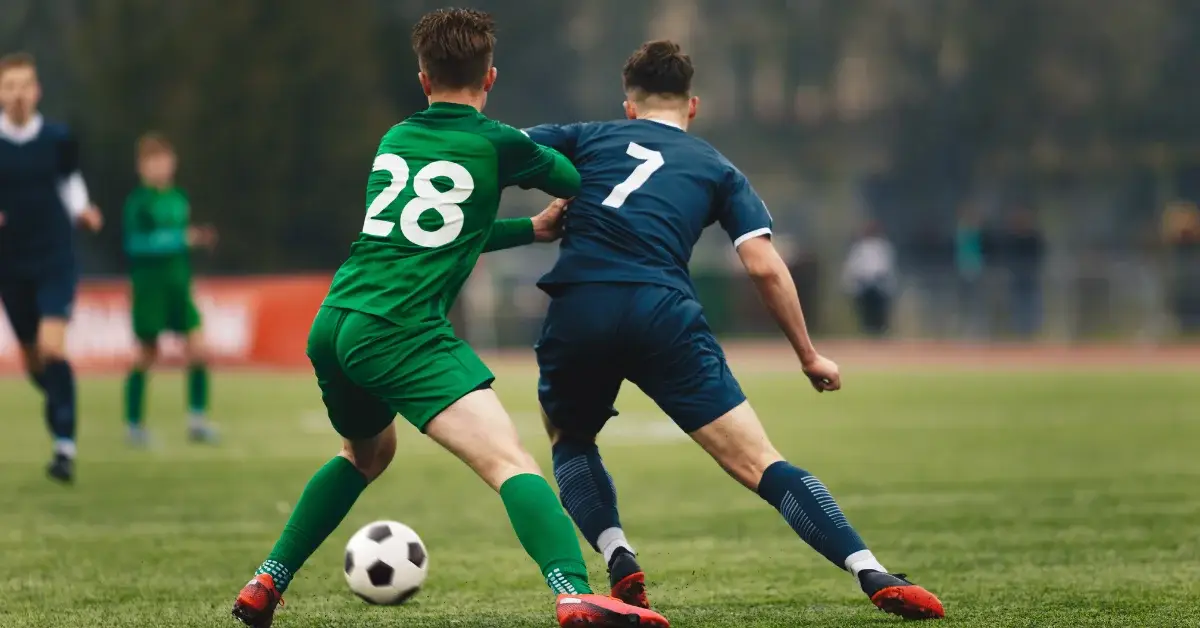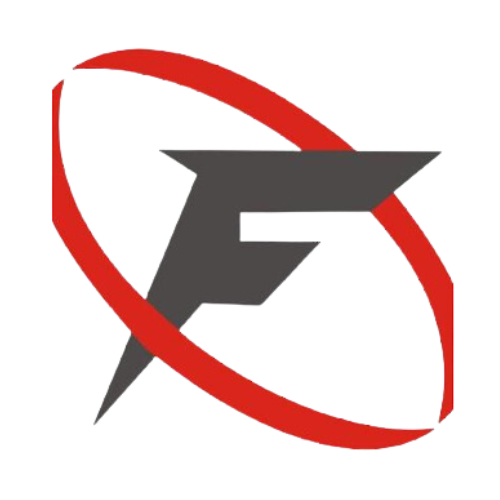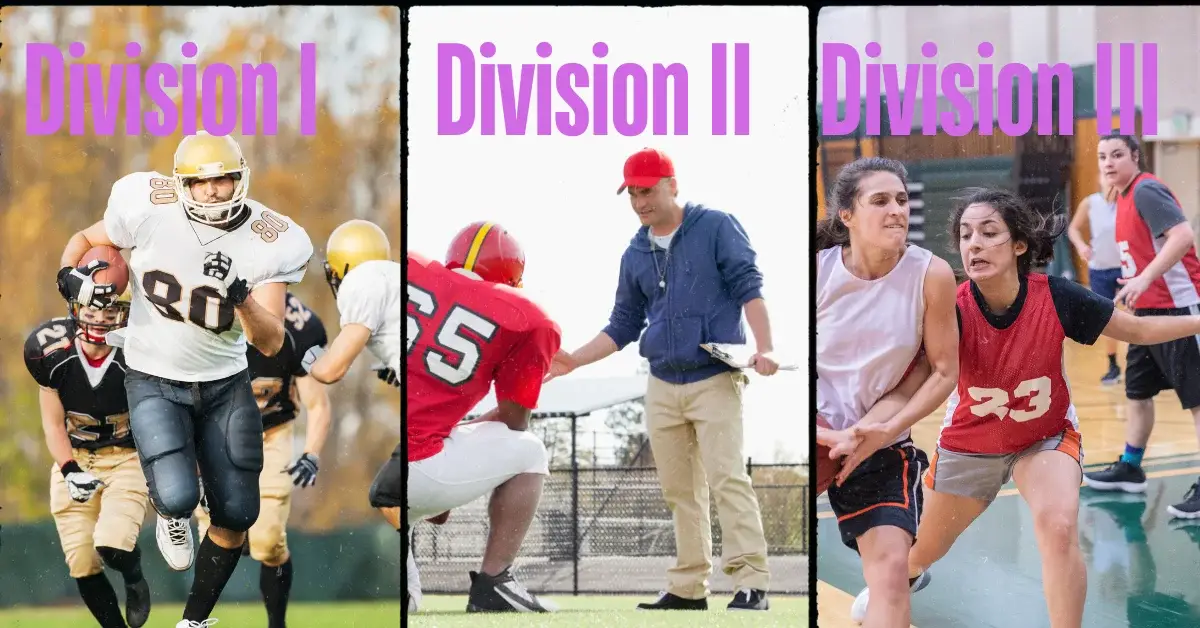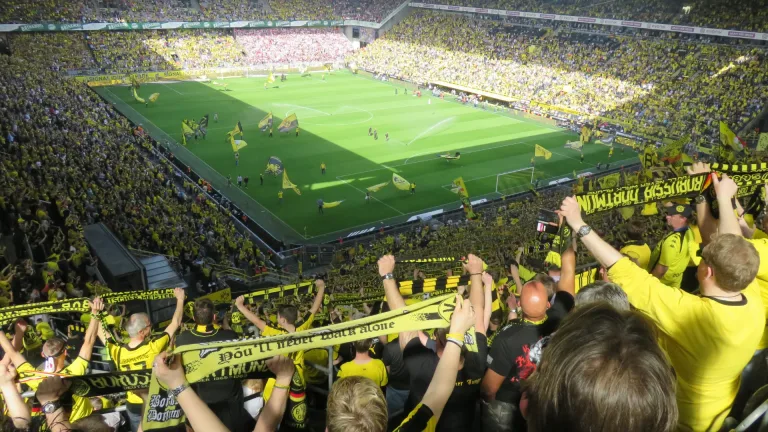Understanding D1, D2, and D3 in College Sports
Thinking about college sports? Understand the real differences between D1, D2, and D3 divisions. Learn how each level impacts your athletic and academic life, and get practical tips to choose the best path for your future.
Choosing a college and a sports division is a big decision for any young athlete. The differences between Division 1 (D1), Division 2 (D2), and Division 3 (D3) can shape your entire college experience, both on and off the field. Understanding what each division offers, from the level of competition to scholarship opportunities, is crucial for making the right choice.
In this blog, I’ll share what I’ve learned about D1, D2, and D3, giving you a clear picture of what to expect and helping you decide which path is best for you.
What Do D1, D2, and D3 Stand For?
D1, D2, and D3 are short for Division 1, Division 2, and Division 3. These terms refer to the different levels of college sports in the United States, as organized by the National Collegiate Athletic Association (NCAA).
Division 1 (D1)
Division 1 is the highest level of college sports. Schools in this division have the largest athletic budgets, the most athletic scholarships, and the highest level of competition. D1 schools often have state-of-the-art facilities and attract top-tier athletes. Examples of D1 schools include major universities like Ohio State, UCLA, and Alabama.
Division 2 (D2)
Division 2 schools still offer a high level of competition but with a greater balance between athletics and academics. D2 schools provide some athletic scholarships, though not as many as D1 schools. These colleges often have a more regional focus. Examples of D2 schools include Bentley University, Grand Valley State, and California State University, Chico.
Division 3 (D3)
Division 3 is known for its emphasis on academics. Schools in this division do not offer athletic scholarships but instead focus on providing a well-rounded college experience. The level of competition is lower than D1 and D2, but still competitive. Examples of D3 schools include Amherst College, Johns Hopkins University, and Williams College.

Key Differences Between Division 1, Division 2, and Division 3
Athletic Competition
Division 1 (D1)
- D1 schools are known for their highly competitive athletic programs. These institutions often recruit top high school athletes and have rigorous training schedules.
- Teams in D1 compete at the highest level and participate in major national tournaments and championships.
- Examples: the University of Michigan, Stanford University, and the University of Texas.
Division 2 (D2)
- D2 offers a competitive athletic environment but with a balance between sports and academics. Athletes in D2 might not face the same level of pressure as those in D1.
- D2 schools often compete in regional tournaments and have a strong emphasis on the student-athlete experience.
- Examples: Ashland University, Florida Southern College, and Seattle Pacific University.
Division 3 (D3)
- D3 focuses on providing a well-rounded college experience with an emphasis on academics. The athletic competition is serious but not as intense as in D1 or D2.
- D3 schools do not offer athletic scholarships, which means athletes often play for the love of the sport and personal development.
- Examples: Middlebury College, Emory University, and Swarthmore College.
| Level of Competition | Scholarships Available | Academic Requirements | |
|---|---|---|---|
| NCAA D1 | No athletic scholarships are available. | Widely available, typically higher limits per team. | 2.2 GPA 16 core course requirements |
| NCAA D2 | Still competitive, attracts top talent worldwide | Widely available, but full scholarships are rare. | It’s less intense but still competitive. |
| NCAA D3 | There are no set requirements. The school has its own requirements. | Less intense but still competitive. | It’s less intense but still competitive. |
Scholarships
Division 1 (D1)
- D1 schools offer the most athletic scholarships, which can cover a significant portion or even all of a student’s tuition, room, and board.
- Scholarships are often awarded based on athletic performance, with many full-ride scholarships available.
Division 2 (D2)
- D2 schools offer athletic scholarships, but they are generally fewer and smaller than those in D1. Scholarships might cover only part of the tuition and expenses.
- Athletes often receive a combination of athletic, academic, and need-based scholarships.
Division 3 (D3)
- D3 schools do not offer athletic scholarships. Instead, they provide financial aid based on academic performance and financial need.
- The focus is ensuring student-athletes succeed academically and enjoy a balanced college life.
Academic Requirements
Division 1 (D1)
- D1 athletes must meet high academic standards the NCAA sets, including minimum GPA and standardized test scores.
- The demands on time are significant, with athletes balancing intensive training and competition schedules with their studies.
Division 2 (D2)
- D2 athletes also need to meet NCAA academic requirements, which are generally less stringent than those for D1.
- There is a strong emphasis on balancing academics and athletics, with support systems in place to help student-athletes succeed.
Division 3 (D3)
- D3 places the highest emphasis on academics. Student-athletes must meet the general admissions standards of their college or university.
- The athletic schedule is designed to allow students to focus on their studies with more flexibility and less time commitment compared to D1 and D2.
Examples of Schools in Each Division
Division 1 (D1)
Division 1 schools are known for their strong athletic programs and significant resources. Here are a few notable examples:
- University of Michigan: Known for its outstanding football program and a wide range of other competitive sports teams.
- Stanford University: Famous for excelling in various sports, consistently leading in NCAA championships.
- University of Texas at Austin: This university offers strong programs in football, basketball, and other sports and has a large, dedicated fan base.
Division 2 (D2)
Division 2 schools balance competitive athletics with a focus on academics and student life. Some examples include:
- Ashland University is known for its strong track and field program and supportive student-athlete environment.
- Florida Southern College: Offers competitive sports programs, especially in basketball and baseball, with a balance on education.
- Seattle Pacific University: Provides a competitive athletic experience with a strong emphasis on academic achievement and personal growth.
Division 3 (D3)
Division 3 schools emphasize academics while still offering competitive sports programs. Notable examples include:
- Middlebury College: Renowned for its strong focus on academics and competitive programs in sports like soccer and skiing.
- Emory University: Balances rigorous academics with competitive athletics, particularly in swimming and tennis.
- Swarthmore College: Known for its academic excellence and competitive sports programs in sports like soccer and lacrosse.

Eligibility and Participation
Division 1 (D1)
Eligibility Requirements
- Academic Standards: D1 athletes must meet NCAA academic eligibility requirements, including a minimum GPA in core courses and standardized test scores (SAT or ACT).
- Amateurism: Athletes must maintain their amateur status, meaning they cannot have accepted money or benefits for playing their sport.
- Initial Eligibility: Prospective D1 athletes must register with the NCAA Eligibility Center and meet its requirements to compete in college sports.
Participation
- Time Commitment: D1 athletes typically have intense training and competition schedules, often dedicating upwards of 20 hours per week to their sport.
- Support Systems: Many D1 schools offer extensive support systems, including tutoring, academic advising, and athletic training services.
- Travel: Competing at the D1 level often involves significant travel for games and tournaments, which can impact academic schedules.
Division 2 (D2)
Eligibility Requirements
- Academic Standards: D2 athletes also need to meet NCAA academic requirements, which are slightly less stringent than those for D1. However, a minimum GPA in core courses and standardized test scores are still required.
- Amateurism: Like D1, D2 athletes must maintain their amateur status.
- Initial Eligibility: Prospective D2 athletes must also register with the NCAA Eligibility Center and meet its requirements.
Participation
- Time Commitment: D2 athletes have a more balanced schedule and often spend 15-20 hours per week on their sport.
- Support Systems: D2 schools provide academic and athletic support, though resources may be more limited than those of D1 schools.
- Travel: While travel is still involved, it is typically less extensive than in D1, with more regional competition.
Division 3 (D3)
Eligibility Requirements
- Academic Standards: D3 athletes must meet the general admissions standards of their college or university, with no specific NCAA eligibility requirements for standardized test scores or core courses.
- Amateurism: D3 athletes must maintain their amateur status, adhering to the same principles as D1 and D2 athletes.
Participation
- Time Commitment: D3 athletes typically have the most flexibility, with sports taking up around 10-15 hours per week. This allows for a stronger focus on academics and extracurricular activities.
- Support Systems: While D3 schools provide support for student-athletes, the resources are often more integrated into the general student services.
- Travel: Travel is usually regional, minimizing the impact on academics and personal life.
Pros and Cons of Each Division
Division 1 (D1)
Pros
- High Level of Competition: D1 offers the highest level of competition, which can be attractive for top athletes looking to challenge themselves and compete at the highest level.
- Extensive Resources: D1 schools often have top-tier facilities, coaching staff, and support systems, including academic tutoring and athletic training.
- Scholarship Opportunities: Many full athletic scholarships are available, which can significantly reduce the cost of college.
- Visibility and Exposure: D1 athletes often compete in nationally televised games and have greater opportunities to be scouted by professional leagues.
Cons
- Intense Time Commitment: The demanding schedule can be overwhelming, leaving less time for academics, social activities, and personal interests.
- High Pressure: The competition and expectations can create a high-pressure environment, which may be stressful for some athletes.
- Limited Flexibility: Balancing sports and academics can be challenging, with less flexibility in managing both commitments.
Division 2 (D2)
Pros
- Balanced Experience: D2 offers a good balance between athletics and academics, allowing athletes to excel in both areas.
- Scholarship Availability: While not as extensive as D1, D2 schools offer athletic scholarships that can help offset tuition costs.
- Supportive Environment: D2 schools emphasize the overall student-athlete experience, providing support systems to help athletes succeed both on and off the field.
- Regional Competition: Less travel compared to D1, which can reduce the impact on academics and personal life.
Cons
- Moderate Resources: D2 schools may have fewer resources and smaller athletic budgets than D1, which can affect facilities and support services.
- Less Visibility: D2 athletes may have fewer opportunities for national exposure and professional scouting.
- Competitive, but Less Intense: While still competitive, the level of play in D2 may not be as high as in D1, which might not appeal to top-tier athletes.
Division 3 (D3)
Pros
- Focus on Academics: D3 schools prioritize academics, allowing student-athletes to engage in their studies and pursue other interests fully.
- Balanced Lifestyle: The time commitment for sports is more manageable, giving athletes the flexibility to participate in extracurricular activities and enjoy a well-rounded college experience.
- Personal Development: Playing sports in D3 is often driven by passion and personal growth rather than pursuing professional careers.
- Strong Community: D3 schools often foster a close-knit community, providing a supportive and inclusive environment for student-athletes.
Cons
- No Athletic Scholarships: D3 schools do not offer athletic scholarships, which can make affording college more challenging for some students.
- Lower Level of Competition: The level of athletic competition in D1 and D2 is lower than in D1 and D2, which might not satisfy highly competitive athletes.
- Limited Resources: D3 programs typically have fewer resources and smaller budgets, affecting facilities, coaching, and support services.
Check out My Journey Understanding PWO Offers: What They Are and How They Can Benefit You.
Frequently Asked Questions (FAQs)
What factors should I consider when choosing a division?
Consider your athletic skill level, academic goals, and personal preferences. Division 1 offers the highest level of competition and extensive resources but requires a significant time commitment. Division 2 balances athletics and academics with regional competition and moderate resources. Division 3 focuses on scholars and provides a flexible schedule with a supportive community, though it lacks athletic scholarships.
How do athletic scholarships work in each division?
Division 1 schools offer the most athletic scholarships, including full rides for top athletes. Division 2 schools provide partial scholarships, combining athletic, academic, and need-based aid. Division 3 schools do not offer athletic scholarships but provide financial assistance based on academic performance and financial need.
Can I transfer between divisions?
Yes, transferring between divisions is possible, but it involves meeting certain NCAA eligibility requirements and may affect your athletic eligibility. Consult with the athletic departments of both your current and prospective schools for guidance on the transfer process.
How does participating in college sports affect my academic life?
In Division 1, the intense schedule requires strong time management skills to balance academics and athletics. Division 2 offers a more balanced approach, with support systems to help you succeed in both areas. Division 3 prioritizes academics, offering the most flexibility to manage your studies and sports commitments.
What kind of support systems are available for student-athletes?
Support systems vary by division and school. Division 1 schools typically offer extensive resources, including tutoring, academic advising, and athletic training. Division 2 and 3 schools also provide support, though resources may be more limited. Look for schools with strong academic and athletic support services that meet your needs.
How important is it to visit potential colleges?
Visiting potential colleges is crucial. It allows you to experience the campus culture, meet coaches and current athletes, and assess the facilities and support services. It helps you determine if the school is the right fit for your academic, athletic, and personal goals.
What should I do if I want to play sports in college but don’t have a scholarship?
If you want to play sports in college without a scholarship, consider Division 3 schools, which do not offer athletic scholarships but still provide competitive sports programs. Additionally, many Division 1 and 2 schools allow walk-ons, athletes who join the team without a scholarship, though this may be more competitive.
How can I improve my chances of being recruited?
To improve your chances of being recruited:
- Maintain strong academic performance.
- Create a highlight reel showcasing your athletic abilities.
- Attend recruitment camps and showcases.
- Reach out to college coaches with your athletic resume and game footage.
- Register with the NCAA Eligibility Center.
Final Thoughts:
Choosing the right college sports division is crucial for your future. Division 1 offers top-tier competition and resources, Division 2 balances athletics and academics, and Division 3 focuses on academic excellence and a well-rounded experience. Consider your goals and what each division can offer you.
For more personalized guidance, reach out to Fredrick International. We’re here to help you navigate your journey to college sports success.
What division do you think aligns best with your goals and why?
Additional Resources
To further assist you in making an informed decision about which college sports division is right for you, here are some valuable resources:
NCAA Official Website
- NCAA Division I, II, and III: The NCAA website provides comprehensive information on each division, including rules, regulations, and eligibility requirements.
College Athletic Departments
- Contact Information: Contact the athletic departments of colleges you are interested in. They can provide specific details about their programs, facilities, and support systems.
Recruitment Guides
- NCAA Eligibility Center: The NCAA Eligibility Center is an essential resource for high school athletes planning to compete in college sports. It offers guidance on academic standards, registration, and maintaining eligibility.
- Recruiting Services: Consider using recruiting services like NCSA (Next College Student Athlete) or CaptainU, which can help connect you with college coaches and provide personalized recruiting advice.
Testimonials and Blogs
- Student-Athlete Experiences: Read blogs and testimonials from current and former student-athletes to gain insights into the realities of competing in D1, D2, and D3 sports.
- Forums and Communities: Join online forums and communities such as Reddit’s r/CollegeBasketball or College Confidential to discuss and learn from the experiences of other athletes and their families.
Financial Aid Resources
- Scholarship Databases: Utilize scholarship databases like Fastweb, Cappex, and College Board to find academic and need-based scholarships that can complement athletic scholarships.
- Financial Aid Offices: Contact the financial aid offices of your prospective schools to understand the financial support available, including grants, loans, and work-study opportunities.
Academic Support
- Tutoring Services: Many schools offer academic tutoring and support services specifically for student-athletes. Check with the educational support center at your prospective schools.
- Time Management Workshops: Attend workshops or seminars on time management and balancing academics and athletics, often provided by high school counselors or community organizations.








One Comment
Comments are closed.